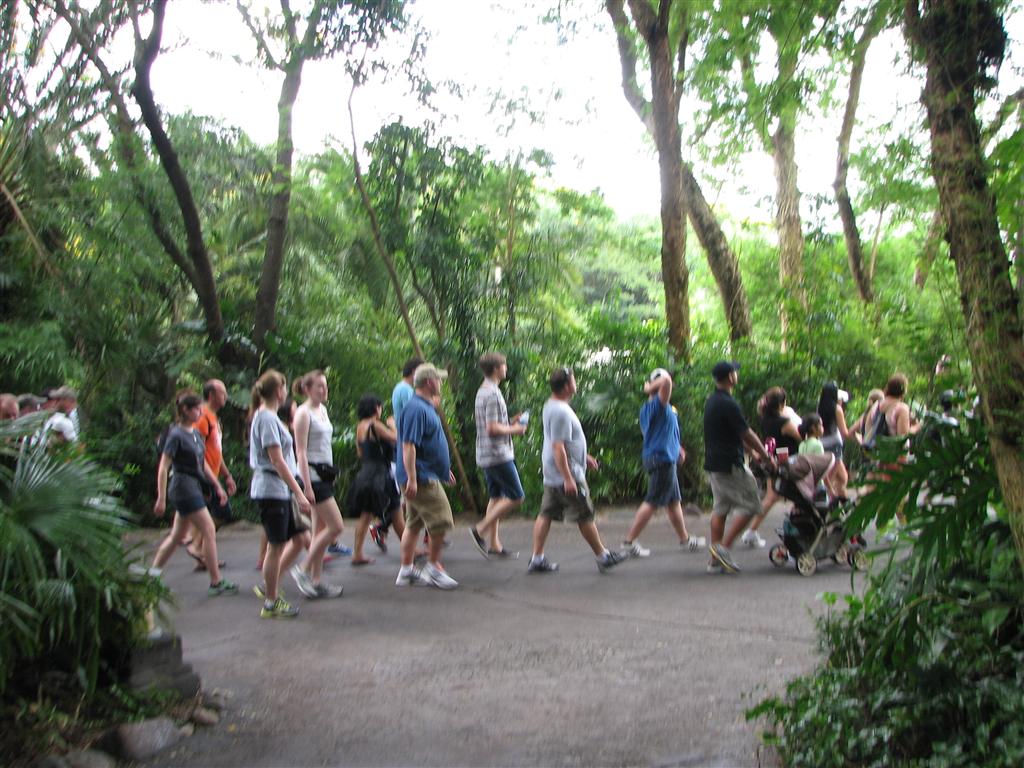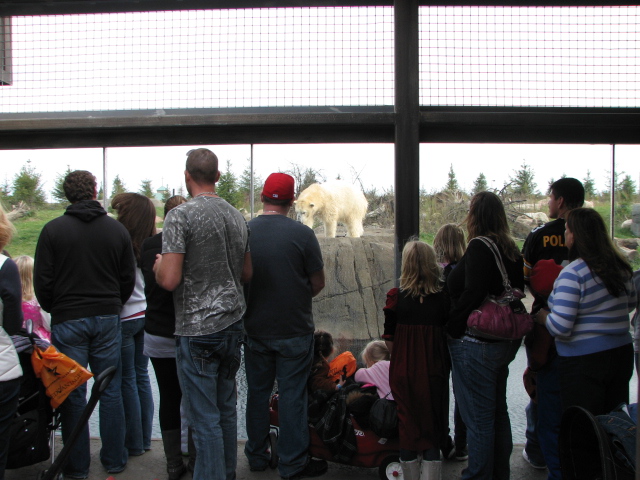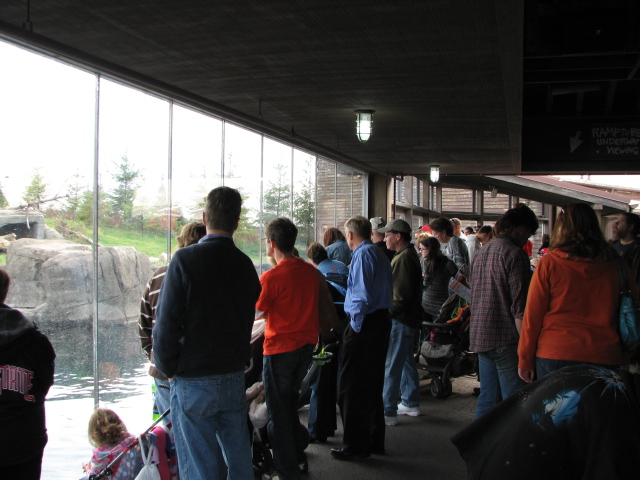By Eileen Ostermeier
Zoos have long been at the forefront of animal research, but only recently have they started conducting studies on another important but relatively overlooked species: their visitors. For decades, museums, science centers, theme parks and National Parks have been studying their visitors – long before the practice was seen as useful in the zoo world. Yet in this age of information, with competing attractions vying for attention, visitor studies are more useful than ever. Moreover, ever-accelerating technological advances and new methods of gathering and analyzing data have made it possible for Zoos to gain a greater understanding of their visitors than ever before. But more research on visitors is needed, generated not just by Zoos and their umbrella organizations (like the AZA) but also by zoo designers themselves.
Why Conduct Visitor Studies?
Why should zoos and related organizations study zoo visitors? Organizations (like the AZA and EAZA) that are dedicated to the advancement of zoos should use visitor studies to evaluate whether and how zoos are meeting the broad goals of conservation, research, education and recreation. The AZA recently conducted a broad, multi-institutional study, Why Zoos & Aquariums Matter: Assessing the Impact of a Visit to a Zoo or Aquarium (AZA, 2007), which focused on the impact of zoos on conservation knowledge, attitudes and behavior. In essence, such studies help justify the existence of zoos. Individual zoos, meanwhile, should study visitors to measure the impact of their messaging and to evaluate whether their institution is meeting its stated goals. And from a practical standpoint, zoos could use visitor studies to increase revenue generation and to improve the economics of zoo business.
 But what about the role of zoo designers? Traditionally, most visitor research has been conducted by the institutions themselves. Recently, however, designers are taking a more active role in studying how visitors behave in and respond to zoo exhibits. PGAV Destinations, for example has not only conducted market research on zoo visitors but has also sent its designers into the field to conduct timing and tracking studies on zoo visitors. Fueled with hard data and facts from their studies, designers are making more-informed decisions about exhibit design. Moreover, such studies can inform all stages of design, from early concept work and master planning to the detailed design of specific exhibit elements. Visitor studies allow designers to more-fully understand the impact of various factors on visitor behavior. For example: designers might test the impact of path width on crowd movements and density, or the correlation between the length of a viewing window and length of stay, and so on. Visitor studies also help set realistic expectations about visitor response to new exhibits (dwell time, level of engagement, etc.). In fact, the predictive power of visitor studies is arguably their most useful benefit. Visitor studies can be used not only to test design decisions and to determine the relative success of existing exhibits but also (and perhaps more importantly) to inform the design of future exhibits.
But what about the role of zoo designers? Traditionally, most visitor research has been conducted by the institutions themselves. Recently, however, designers are taking a more active role in studying how visitors behave in and respond to zoo exhibits. PGAV Destinations, for example has not only conducted market research on zoo visitors but has also sent its designers into the field to conduct timing and tracking studies on zoo visitors. Fueled with hard data and facts from their studies, designers are making more-informed decisions about exhibit design. Moreover, such studies can inform all stages of design, from early concept work and master planning to the detailed design of specific exhibit elements. Visitor studies allow designers to more-fully understand the impact of various factors on visitor behavior. For example: designers might test the impact of path width on crowd movements and density, or the correlation between the length of a viewing window and length of stay, and so on. Visitor studies also help set realistic expectations about visitor response to new exhibits (dwell time, level of engagement, etc.). In fact, the predictive power of visitor studies is arguably their most useful benefit. Visitor studies can be used not only to test design decisions and to determine the relative success of existing exhibits but also (and perhaps more importantly) to inform the design of future exhibits.
What Studies Exist?
 Who can we learn from? Historically, museums, science centers and National Parks have conducted detailed visitor studies. In fact, much of the current information regarding visitor behavior is taken from the museum world, where researchers are constantly evaluating the success of their exhibitions. Further afield, researchers should learn not only from the work of traditional research outlets (like educational psychology, sociology, and environmental science) but also from more unexpected disciplines (like marketing and consumer research). As an example: one researcher noted the similarity of zoo visitor studies to his own research on shopping behavior in grocery stores (Yalowitz & Bronnenkant, 2009). Finally, Theme Parks and similar entertainment destinations – with particular strengths in quantifying visitor flow, tracking & timing, and revenue generation – are a vast and relatively untapped resource in the Zoo world.
Who can we learn from? Historically, museums, science centers and National Parks have conducted detailed visitor studies. In fact, much of the current information regarding visitor behavior is taken from the museum world, where researchers are constantly evaluating the success of their exhibitions. Further afield, researchers should learn not only from the work of traditional research outlets (like educational psychology, sociology, and environmental science) but also from more unexpected disciplines (like marketing and consumer research). As an example: one researcher noted the similarity of zoo visitor studies to his own research on shopping behavior in grocery stores (Yalowitz & Bronnenkant, 2009). Finally, Theme Parks and similar entertainment destinations – with particular strengths in quantifying visitor flow, tracking & timing, and revenue generation – are a vast and relatively untapped resource in the Zoo world.
In the past couple of decades, Zoos have started conducting their own visitor studies. Organizations have begun compiling resources and developing literature reviews, like Visitor Learning in Zoos and Aquariums: A Literature Review (Dierking, Lynn, et al, 2001-2002). Of particular note is a recent, comprehensive, multi-institutional and cross-discipline effort by the EAZA to compile a list of relevant visitor studies: Looking at People Looking at Animals: An International Bibliography on Visitor Experience Studies and Exhibit Evaluation in Zoos and Aquariums (EAZA Education Committee, 2011). A particular strength of current studies is the focus on interpretation, education, and the impact of conservation messaging on zoo visitors.
What Studies Should Be Conducted?
Because of their unique position in the Zoo world, groups like the AZA and EAZA should be conducting visitor studies that play to their strengths as broad, multi-institutional organizations. Such groups should conduct more comprehensive, nationwide or international surveys that bridge the gaps between separate Zoos. These should include literature reviews, bibliographies, and cross-institutional visitor studies. Such studies would be particularly useful for comparing the relative success of exhibits at different institutions and for identifying key trends across several Zoos. They may also serve to establish methodological standards and to encourage Zoos to conduct more detailed studies of their own institutions.
 Zoos, meanwhile, should be harvesting a wealth of information about their visitors, with a particular focus on the unique circumstances at their specific institution. It is important for Zoos to understand what makes their zoo different from others – variables ranging from the demographic make-up of its visitors and its region to the institution’s focus, goals, strengths and challenges. What works at one Zoo (e.g. a new polar bear exhibit that draws new visitors by the thousands) does not always work at another. Uniquely positioned to study their visitors, Zoos should use all the resources at their disposal – from the ability to track operational data like hourly attendance and revenue to the dozens of staff and volunteers eager to help.
Zoos, meanwhile, should be harvesting a wealth of information about their visitors, with a particular focus on the unique circumstances at their specific institution. It is important for Zoos to understand what makes their zoo different from others – variables ranging from the demographic make-up of its visitors and its region to the institution’s focus, goals, strengths and challenges. What works at one Zoo (e.g. a new polar bear exhibit that draws new visitors by the thousands) does not always work at another. Uniquely positioned to study their visitors, Zoos should use all the resources at their disposal – from the ability to track operational data like hourly attendance and revenue to the dozens of staff and volunteers eager to help.
But Zoos and their umbrella organizations are not the only groups who should study zoo visitors. Zoo designers should be conducting visitor studies as well. Such studies should be targeted and detailed, focusing on a specific factor, variable or design criteria the zoo designers wish to better understand through data and facts. For example, Zoo designers may wish to study the impact of exhibit temperature (say, at indoor cold-weather penguin exhibits) on dwell time, level of engagement, and walking speed. Or they may study the impact of the size of an underwater viewing window on the length of stay and the number of viewers the window can reasonably accommodate at any given time. Likewise for other factors like water clarity, animal activity, path width, type of interpretive elements, level of cultural theming, and the like. Studying the impact of specific design variables should inform future design decisions and lead to better understanding of what makes an exhibit successful. Tracking and timing studies – those that focus on factors like dwell time, crowd flow, level of engagement, etc. – are particularly useful for designers. But few zoo designers are currently studying visitors. Those that are have a distinct advantage over their counterparts.
 Issues
Issues
Despite the recent insurgence of zoo visitor studies, the field is plagued by a number of issues. Studies are done sporadically by separate institutions, which are sometimes reluctant to share their results. Those that are published are often difficult to compare, due to inconsistent criteria, small sample sizes, and idiosyncratic results (usually resulting from poor study design). This is particularly problematic when trying to evaluate the relative success of different exhibits at different institutions. Fortunately, several researchers have made recommendations regarding methodology and indicators for comparison – including dwell time and the Sweep Rate Index (SRI), which standardizes for different exhibit sizes (Yalowitz & Bronnenkant, 2009).
A bigger issue may be that most of the current research is focused on visitor education, to the neglect of other, important areas. Though a lofty goal, Zoo visitor research should focus on more than just conservation messaging. Besides asking what their visitors are learning, Zoos should also ask questions like: “How can we improve the visitor experience beyond communicating our message? How well are we entertaining as well as educating? Are we generating sufficient revenue to meet our future goals?” Revenue generation, though perhaps less esteemed than interpretation and messaging, is absolutely essential for the Zoo to meet its other goals. Detailed visitor studies can inform everything, from dining menus and the location of food carts or retail (e.g. was that gift shop at the end of the exhibit useful?), to opportunities for high-end experiences, like tours and one-on-one interactive experiences with animals. And most importantly, Zoos should be asking “What’s next?” and looking to the future, of not just their institution but of zoo design itself.
 Trends and the Future of Visitor Studies
Trends and the Future of Visitor Studies
Researchers of visitor behavior should look to the future for new ideas, including new methods of collecting and analyzing data. Technology is increasingly being used as a tool for understanding visitor behavior. Researchers can now use videotaping, hand-held digital devices or software systems for recording and analyzing data (including the Noldus Observer and the Museum Experience Recorder system). Taking this a step further, the Walt Disney Company has reportedly invested more than $1 billion on its so-called “Next Generation Experience” project, a technology and marketing initiative focused on detailed visitor tracking and data-mining. Soon, all visitors to Walt Disney World will wear RFID bracelets throughout the resort, allowing the company to collect detailed data on individual spending habits, crowd movements and more – a literal “marketing bonanza” (Garcia, 2013). What’s next? Eye-tracking software to analyze visitor interest (Ross & Wagner, 2012), or personalized itineraries that visitors can create on digital mobile devices? The possibilities are endless.
Ultimately, designers should take a much greater role in conducting visitor studies. Designers may think they know what constitutes good zoo design, but they should confirm their assumptions and back them up with data and facts. The best way to do this is to conduct detailed studies of zoo visitors and factors that impact their designs. There is enormous potential to benefit from the wealth of information out there, just waiting to be collected, analyzed and understood. Designers should take the lead in studying the visitors that come to their Zoos.
Bibliography
Association of Zoos & Aquariums. "Why Zoos & Aquariums Matter: Assessing the Impact of a Visit to a Zoo or Aquarium." 2007. Association of Zoos & Aquariums. Web. 27 December 2012. <http://www.aza.org/uploadedFiles/Education/why_zoos_matter.pdf>.
Dierking, Lynn, et al. "Visitor Learning in Zoos and Aquariums: A Literature Review." 2001-2002. International Zoo Educators Association. Web. 27 December 2012. <http://www.izea.net/education/AZA-Visitor_Leaning_in_Zoos_Aquraiums_Literature_Review.pdf>.
EAZA Education Committee. "Looking at People Looking at Animals: An International Bibliography on Visitor Experience Studies and Exhibit Evaluation in Zoos and Aquariums." February 2011. European Association of Zoos and Aquaria. Web. 27 December 2012. <http://www.eaza.net/activities/education/Documents/2011-02-10%20Visitor%20Studies%20Bibliography%20%20V0.3.pdf>.
Francis, David, Maggie Esson and Andrew Moss. "Following Visitors and What It Tells Us: The Use of Visitor Tracking to Evaluate ‘Spirit of the Jaguar’ at Chester Zoo." 2007. International Zoo Educators Association. Web. 27 December 2012. <http://www.izea.net/education/journal%202007%20following%20visitors%20and%20what%20it%20tells%20us.pdf>.
Garcia, Jason. "Orlando Sentinel." 2013 7 January. Disney reveals NextGen details with 'MyMagic+'. Web. 7 January 2013. <http://www.orlandosentinel.com/the-daily-disney/os-disney-reveals-next-gen-details-20130107,0,6117836.story>.
Ridgway, Stephanie Clark, Margaret Livingston and Steven E. Smith. "Visitor Behavior In Zoo Exhibits With Underwater Viewing." Visitor Studies Today 2005: 1, 3-10. Web. 27 December 2012. <http://ag.arizona.edu/research/azalfalf/pdf_pubs/zoo_visitor_behavior.pdf>.
Ross, Steve and Kathleen Wagner. "Visitor Behavior in Zoos and Aquariums." Connect: Association of Zoos & Aquariums May 2012: 42-43. Print.
Yalowitz, Steven S. and Kerry Bronnenkant. "Timing and Tracking: Unlocking Visitor Behavior." Visitor Studies 12.1 (2009): 47-64. Web. 2012 27 December. <http://www.tandfonline.com/doi/pdf/10.1080/10645570902769134>.
Eileen Ostermeier studied architecture at Washington University in St. Louis and later received her Masters in Landscape Architecture from The Ohio State University, where she focused on habitat design and restoration. She has been with PGAV for 4 years and is currently working on Safari Africa! at the Columbus Zoo. eileen.ostermeier@pgav.com





















